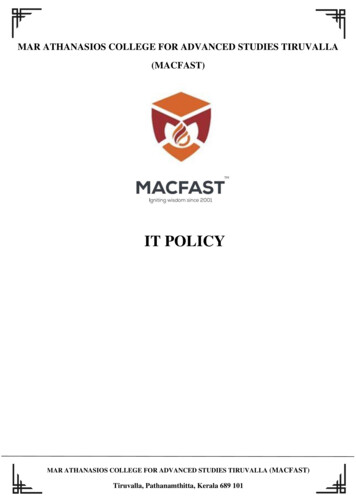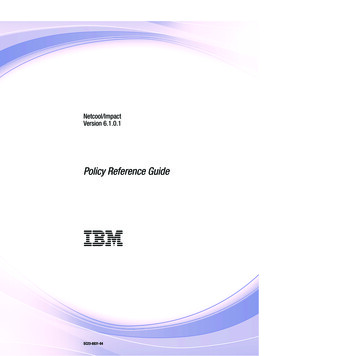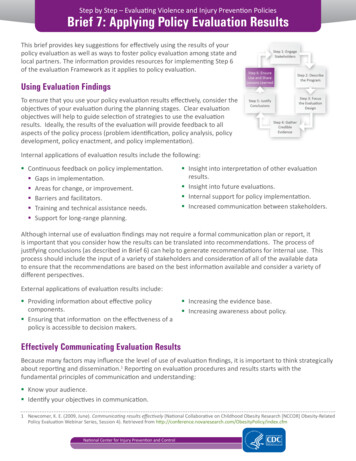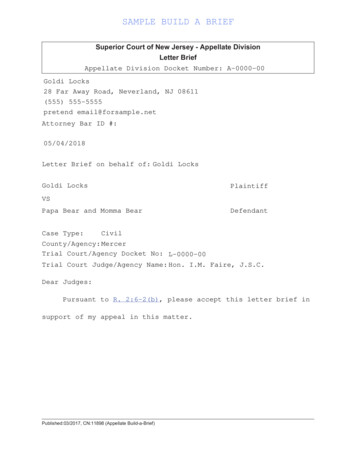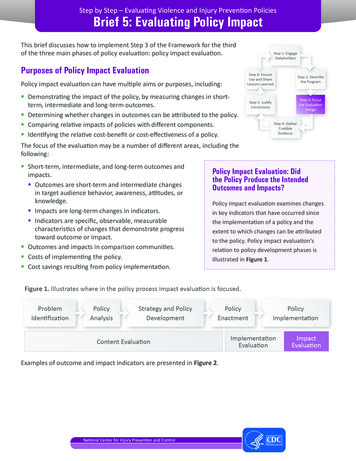
Transcription
Step by Step – Evaluating Violence and Injury Prevention PoliciesBrief 5: Evaluating Policy ImpactThis brief discusses how to implement Step 3 of the Framework for the thirdof the three main phases of policy evaluation: policy impact evaluation.Purposes of Policy Impact EvaluationPolicy impact evaluation can have multiple aims or purposes, including: Demonstrating the impact of the policy, by measuring changes in shortterm, intermediate and long-term outcomes. Determining whether changes in outcomes can be attributed to the policy. Comparing relative impacts of policies with different components. Identifying the relative cost-benefit or cost-effectiveness of a policy.The focus of the evaluation may be a number of different areas, including thefollowing: Short-term, intermediate, and long-term outcomes andimpacts. Outcomes are short-term and intermediate changesin target audience behavior, awareness, attitudes, orknowledge. Impacts are long-term changes in indicators. Indicators are specific, observable, measurablecharacteristics of changes that demonstrate progresstoward outcome or impact. Outcomes and impacts in comparison communities. Costs of implementing the policy. Cost savings resulting from policy implementation.Policy Impact Evaluation: Didthe Policy Produce the IntendedOutcomes and Impacts?Policy impact evaluation examines changesin key indicators that have occurred sincethe implementation of a policy and theextent to which changes can be attributedto the policy. Policy impact evaluation’srelation to policy development phases isillustrated in Figure 1.Examples of outcome and impact indicators are presented in Figure 2.National Center for Injury Prevention and Control
Sample Impact Evaluation QuestionsOnce the purpose and focus of the evaluation are determined,you should identify specific evaluation questions. Theevaluation questions you choose will guide your selection of anappropriate evaluation design. The following are some samplepolicy impact evaluation questions. Was there a change in the outcomes and impacts ofinterest? Did the policy contribute to a change in the outcomes andimpacts of interest? Were there any unintended consequences of the policy? Did contextual factors influence the level of impact? What was the economic impact of the policy (costeffectiveness or cost benefit)?Evaluation Design ConsiderationsEvaluating a Change in Outcomes, and ImpactsEvaluating Impact of ProductDesign ChangesTo evaluate a voluntary performancestandard for infant walkers thatsuggested that walkers be designed tobe too wide for a standard doorwayor incorporate a braking mechanism,Shields and Smith found a 75% decreasein infant-walker–related injuries byconducting a retrospective pre-postdesign that examined injury rates beforeand after the standard was established.This decrease was demonstrated througha retrospective analysis of data from theNational Electronic Injury SurveillanceSystem maintained by the U.S. ConsumerProduct Safety Commission.2When the evaluation question focuses on identifying changes in the indicators, regardless of whether or notthe changes were necessarily a result of the policy itself, the team can use non-experimental or descriptivedesigns. However, be sure to represent accurately what the results of this analysis demonstrate. Nonexperimental designs are unable to clearly link the impacts to the policy because they are unable to rule outalternative explanations for the impacts.1 These types of designs are most appropriate when it is impossibleor impractical to compare changes over time or to use a comparison group. Two potential non-experimentaldesigns for impact evaluation are cross-sectional and case study.2Establishing a Link Between a Policy and Changes in Outcomes and ImpactsA randomized experimental design is sometimes considered the gold standard for conducting an impactevaluation because it produces the strongest evidence that a project, program, or policy contributed tochanges in behavior or other outcomes.3,4,5 However, when you are evaluating the impact of a policy on apopulation, randomization may be unethical or impossible, not to mention costly or time-consuming. Quasiexperimental designs can be used to evaluate changes in indicators over time or compared to a group notaffected by the policy. Refer to Appendix O for further description of these methods. 61 Her Majesty’s Treasury. (2011). The magenta book: Guidance for evaluation. London, UK: Author. Retrieved from http://www.hm-treasury.gov.uk/data magentabook index.htm2 Shields, B. J., & Smith, G. A. (2006). Success in the prevention of infant walker-related injuries: An analysis of national data, 1990–2001.Pediatrics, 117, e452-e459.3 W. K. Kellogg Foundation. (1998; rev. 2004). Evaluation handbook. Battle Creek, MI: Author. Retrieved from /W-K-Kellogg-Foundation-Evaluation-Handbook.aspx4 Patton, M. Q. (2011). Essentials of utilization-focused evaluation. Saint Paul, MN: Sage.5 Brownson, R. C., Royer, C., Ewing, R., & McBride, T. D. (2006). Researchers and policy makers: Travelers in parallel universes. American Journal ofPreventive Medicine, 30, 164–172.6 Markowitz, S., Nesson, E., Poe-Yamagata, E., Florence, C., Roberts, T., & Link, S. B. (2011, June). Estimating the relationship between alcoholpolicies and youth violence. Retrieved from ce%20Paper%20October%202011.pdf2Step by Step – Evaluating Violence and Injury Prevention Policies
A number of factors can make it easier or harder to make the case for a causal relationship between the policyand the observed changes in outcomes. These factors include the following2: Nature of the relationship between the policy and the impacts.Expected magnitude of change in impact.Expected length of time to see evidence of the policy effects.Nature and extent of external influences on impact.Availability of data.Extent of implementation (availability of natural comparison groups).Comparison GroupsIn many cases, you may be able only to assert somecontribution of the policy to the outcomes and impacts. Usingcomparison groups is one method that can increase yourconfidence that the policy is responsible for the change inindicators. A comparison between groups whose membershave not been randomly assigned is known as non-equivalentcomparison design. Although groups similar to the communityor group being affected by the policy may be selected, thegroups are not equivalent, regardless of how similar they mayappear. Some additional steps may be required during analysesand interpretation to demonstrate the appropriateness ofthe comparison group.7 If you are unable to compare a groupaffected by a policy with a group not affected by a policy, youmay be able to make comparisons between the groups thathave been affected by a policy. For example, an evaluationmay compare the impact of a universal school-based violenceprevention policy between different schools, different gradelevels, or different levels of implementation.Evaluation of Cost Versus Benefit8Modeling the Impact of AlcoholControl Policies on Youth ViolenceUsing data from the Youth Risk BehavioralSurveillance Survey as well as area-levelalcohol policy information, Markowitzand colleagues used statistical modelingto examine the impact of various alcoholcontrol policies on measures of youthviolence and drinking. They obtaineddata on 18 different alcohol controlpolicy variables from the Alcohol PolicyInformation System (available from theNational Institute on Alcohol Abuse andAlcoholism) and also contacted stateofficials directly. Merging this informationwith violence data based on respondentresidence and year of survey allowed foran analysis of the relationships betweenthe different policies and youth violence.The analyses provided evidence of anegative relationship between alcoholprices and youth violence.6Economic evaluation methods compare the costs of thepolicy with the resulting benefits. These methods are usedin conjunction with the designs described above becausethey are dependent upon understanding the amount andtypes of changes that occurred as a result of the program. Economic evaluations attempt to place a valueon these changes and then compare this value with the cost of implementing the program. Two types ofeconomic evaluations are cost-benefit and cost-effectiveness studies. Cost-benefit studies estimate andcompare the cost of a policy with the value of the benefit of the policy. Cost-effectiveness studies examine thecost-\ of implementing policy in relation to the resulting positive outcomes or impacts, often in comparison7 CDC, Office of the Associate Director for Program. (2012, September). A framework for program evaluation. Retrieved from http://www.cdc.gov/eval/framework/index.htm8 Faul, M., Wald, M. M., Rutland-Brown, W., Sullivent, E. E., & Sattin, R. W. (2007). Using a cost-benefit analysis to estimate outcomes of a clinicaltreatment guideline: Testing the Brain Trauma Foundation guidelines for the treatment of severe traumatic brain injury. Journal of Trauma, 63,1271–1278.3Step by Step – Evaluating Violence and Injury Prevention Policies
to alternative policies or interventions. Itis important to consider a wide range ofpotential costs and benefits related to thepolicy in order to account for ripple effectswhen evaluating cost and benefits. Economicanalyses can be extremely complicated andshould be thoroughly planned with input froman economist, econometrician, or quantitativepolicy research expert during the planningphase of the evaluation.1General Measurement ConsiderationsImpact evaluations typically rely onquantitative data. Some evaluation designsrequire collection of population-level data atmultiple times over a long period. Surveillancedata is often a cost-effective source of data.Estimating the Cost-Benefit of a PolicyTo examine the cost savings associated with adopting theBrain Trauma Foundation (BTF) guidelines for treatmentof severe traumatic brain injury, Faul and colleagues usedsurveillance systems combined with national surveys.They estimated the lifetime costs of 80% adherence to theguidelines compared with the 33% estimated adherence.Using a decision analysis model, coupled with previousresearch and available surveillance and survey data, theyestimated savings of more than 300 million in medicalcosts and rehabilitation costs if the BTF guidelines werefollowed at 80% adherence. Faul’s team also estimatedthat more than 3,000 additional lives would be saved. Thisexample demonstrates how previous research and availablesurveillance data can estimate the cost benefits of a policy.8Figure 2: Examples of Outcome and Impact IndicatorsShort-Term OutcomesIntermediate OutcomesAwareness of seat belt lawSeat belt useAttitudes toward violenceViolent behaviorAwareness of Brain TraumaAdherence to treatment guidelinesFoundation guidelinesLong-Term ImpactsInjury ratesInjuries from violenceInjury severityIn selecting data collection points, consider the planned and actual roll-out dates of the policy. Make sure datais being collected at time periods that match the evaluation design (before and after implementation). If youare using a comparison group, make sure you have access to data on both the groups.Unintended ConsequencesConsider potential unintended consequences that may occur as a result of the policy implementation.Rely on previous research and evaluations and the experience of stakeholders to brainstorm potentialunintended consequences. Some unintended consequences may be uncovered during the course of policyimplementation. Some examples of potential unintended consequences include: 4Increases in the arrest of intimate partner violence victims as a result of a new arrest policy.Increases in illegal firearm sales as a result of a firearm licensing policy.Increases in child injuries due to airbag deployment as a result of new regulatory requirements.Issues related to access to health care as the result of policies that increase reporting of injuries.Step by Step – Evaluating Violence and Injury Prevention Policies
Potential Policy Impact Evaluation Challenges and SolutionsChallengesSolutionsExternal and contextual factors Measure contextual factors to the extent possible.such as economic conditions or Explore the use of difference in difference analyses which examinepublic awarenessthe difference in the target group while accounting for differences incomparison communities.Length of time required to expect Use an evaluation plan that measures short-term and intermediatelong-term impactsoutcomes that logically link to long-term outcomes.Lack of access to appropriate Identify available pre-existing datasets and explore the possibility ofdatadata linkage to increase analysis possibilities (see Brief 6).Action Steps Identify any resources for planning and implementing an impact evaluation. Identify evaluation questions and identify the most appropriate design given available resources andexpertise. Articulate short-term and intermediate outcomes as well as long-term impacts for a particular policy. Identify data collected in an existing surveillance or administrative system to use for an evaluation.Additional ResourcesThe Magenta Book: Guidance for Evaluation (Her Majesty’s Treasury). Provides general and technicalguidance on policy evaluation. Available at http://www.hm-treasury.gov.uk/data magentabook index.htmPolicy Evaluation Webinar Series (National Collaborative on Childhood Obesity Research). Available at f5Step by Step – Evaluating Violence and Injury Prevention Policies
Expected magnitude of change in impact. Expected length of time to see evidence of the policy effects. Nature and extent of external influences on impact. Availability of data. Extent of implementation (availability of natural comparison groups). Comparison Groups In many cases, you may be able only to assert some



